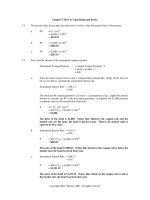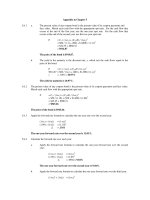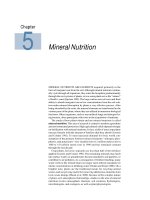Chapter 5 Cpu scheduling
Bạn đang xem bản rút gọn của tài liệu. Xem và tải ngay bản đầy đủ của tài liệu tại đây (744.53 KB, 51 trang )
Chapter 5: CPU Scheduling
Chapter 5: CPU Scheduling
5.2
Silberschatz, Galvin and Gagne ©2005
Operating System Concepts – 7
th
Edition, Feb 2, 2005
Chapter 5: CPU Scheduling
Chapter 5: CPU Scheduling
■
Basic Concepts
■
Scheduling Criteria
■
Scheduling Algorithms
■
Multiple-Processor Scheduling
■
Real-Time Scheduling
■
Thread Scheduling
■
Operating Systems Examples
■
Java Thread Scheduling
■
Algorithm Evaluation
5.3
Silberschatz, Galvin and Gagne ©2005
Operating System Concepts – 7
th
Edition, Feb 2, 2005
Basic Concepts
Basic Concepts
■
Maximum CPU utilization obtained with multiprogramming
■
CPU–I/O Burst Cycle – Process execution consists of a cycle of CPU
execution and I/O wait
■
CPU burst distribution
5.4
Silberschatz, Galvin and Gagne ©2005
Operating System Concepts – 7
th
Edition, Feb 2, 2005
Alternating Sequence of CPU And I/O Bursts
Alternating Sequence of CPU And I/O Bursts
5.5
Silberschatz, Galvin and Gagne ©2005
Operating System Concepts – 7
th
Edition, Feb 2, 2005
Histogram of CPU-burst Times
Histogram of CPU-burst Times
5.6
Silberschatz, Galvin and Gagne ©2005
Operating System Concepts – 7
th
Edition, Feb 2, 2005
CPU Scheduler
CPU Scheduler
■
Selects from among the processes in memory that are ready to execute,
and allocates the CPU to one of them
■
CPU scheduling decisions may take place when a process:
1. Switches from running to waiting state
2. Switches from running to ready state
3. Switches from waiting to ready
4. Terminates
■
Scheduling under 1 and 4 is nonpreemptive
■
All other scheduling is preemptive
5.7
Silberschatz, Galvin and Gagne ©2005
Operating System Concepts – 7
th
Edition, Feb 2, 2005
Dispatcher
Dispatcher
■
Dispatcher module gives control of the CPU to the process selected by the
short-term scheduler; this involves:
●
switching context
●
switching to user mode
●
jumping to the proper location in the user program to restart
that program
■
Dispatch latency – time it takes for the dispatcher to stop one process and
start another running
5.8
Silberschatz, Galvin and Gagne ©2005
Operating System Concepts – 7
th
Edition, Feb 2, 2005
Scheduling Criteria
Scheduling Criteria
■
CPU utilization – keep the CPU as busy as possible
■
Throughput – # of processes that complete their execution per time
unit
■
Turnaround time – amount of time to execute a particular process
■
Waiting time – amount of time a process has been waiting in the
ready queue
■
Response time – amount of time it takes from when a request was
submitted until the first response is produced, not output (for time-
sharing environment)
5.9
Silberschatz, Galvin and Gagne ©2005
Operating System Concepts – 7
th
Edition, Feb 2, 2005
Optimization Criteria
Optimization Criteria
■
Max CPU utilization
■
Max throughput
■
Min turnaround time
■
Min waiting time
■
Min response time
5.10
Silberschatz, Galvin and Gagne ©2005
Operating System Concepts – 7
th
Edition, Feb 2, 2005
First-Come, First-Served (FCFS) Scheduling
First-Come, First-Served (FCFS) Scheduling
Process Burst Time
P
1
24
P
2
3
P
3
3
■
Suppose that the processes arrive in the order: P
1
, P
2
, P
3
The Gantt Chart for the schedule is:
■
Waiting time for P
1
= 0; P
2
= 24; P
3
= 27
■
Average waiting time: (0 + 24 + 27)/3 = 17
P
1
P
2
P
3
24 27 300
5.11
Silberschatz, Galvin and Gagne ©2005
Operating System Concepts – 7
th
Edition, Feb 2, 2005
FCFS Scheduling (Cont.)
FCFS Scheduling (Cont.)
Suppose that the processes arrive in the order
P
2
, P
3
, P
1
■
The Gantt chart for the schedule is:
■
Waiting time for P
1
= 6;
P
2
= 0
;
P
3
= 3
■
Average waiting time: (6 + 0 + 3)/3 = 3
■
Much better than previous case
■
Convoy effect short process behind long process
P
1
P
3
P
2
63 300
5.12
Silberschatz, Galvin and Gagne ©2005
Operating System Concepts – 7
th
Edition, Feb 2, 2005
Shortest-Job-First (SJF) Scheduling
Shortest-Job-First (SJF) Scheduling
■
Associate with each process the length of its next CPU burst. Use these
lengths to schedule the process with the shortest time
■
Two schemes:
●
nonpreemptive – once CPU given to the process it cannot be
preempted until completes its CPU burst
●
preemptive – if a new process arrives with CPU burst length
less than remaining time of current executing process,
preempt. This scheme is know as the
Shortest-Remaining-Time-First (SRTF)
■
SJF is optimal – gives minimum average waiting time for a given set of
processes
5.13
Silberschatz, Galvin and Gagne ©2005
Operating System Concepts – 7
th
Edition, Feb 2, 2005
Process Arrival Time Burst Time
P
1
0.0 7
P
2
2.0 4
P
3
4.0 1
P
4
5.0 4
■
SJF (non-preemptive)
■
Average waiting time = (0 + 6 + 3 + 7)/4 = 4
Example of Non-Preemptive SJF
Example of Non-Preemptive SJF
P
1
P
3
P
2
73 160
P
4
8 12
5.14
Silberschatz, Galvin and Gagne ©2005
Operating System Concepts – 7
th
Edition, Feb 2, 2005
Example of Preemptive SJF
Example of Preemptive SJF
Process Arrival Time Burst Time
P
1
0.0 7
P
2
2.0 4
P
3
4.0 1
P
4
5.0 4
■
SJF (preemptive)
■
Average waiting time = (9 + 1 + 0 +2)/4 = 3
P
1
P
3
P
2
42
11
0
P
4
5 7
P
2
P
1
16
5.15
Silberschatz, Galvin and Gagne ©2005
Operating System Concepts – 7
th
Edition, Feb 2, 2005
Determining Length of Next CPU Burst
Determining Length of Next CPU Burst
■
Can only estimate the length
■
Can be done by using the length of previous CPU bursts, using exponential
averaging
:Define 4.
10 , 3.
burst CPU next the for value predicted 2.
burst CPU of length actual 1.
≤≤
=
=
+
αα
τ
1n
th
n
nt
( )
.1
1 nnn
t
ταατ
−+=
=
5.16
Silberschatz, Galvin and Gagne ©2005
Operating System Concepts – 7
th
Edition, Feb 2, 2005
Prediction of the Length of the Next CPU Burst
Prediction of the Length of the Next CPU Burst
5.17
Silberschatz, Galvin and Gagne ©2005
Operating System Concepts – 7
th
Edition, Feb 2, 2005
Examples of Exponential Averaging
Examples of Exponential Averaging
■
α =0
●
τ
n+1
= τ
n
●
Recent history does not count
■
α =1
●
τ
n+1
= α t
n
●
Only the actual last CPU burst counts
■
If we expand the formula, we get:
τ
n+1
= α t
n
+(1 - α)α t
n
-1 + …
+(1 - α )
j
α t
n
-j
+ …
+(1 - α )
n +1
τ
0
■
Since both α and (1 - α) are less than or equal to 1, each successive term
has less weight than its predecessor
5.18
Silberschatz, Galvin and Gagne ©2005
Operating System Concepts – 7
th
Edition, Feb 2, 2005
Priority Scheduling
Priority Scheduling
■
A priority number (integer) is associated with each process
■
The CPU is allocated to the process with the highest priority (smallest
integer ≡ highest priority)
●
Preemptive
●
nonpreemptive
■
SJF is a priority scheduling where priority is the predicted next CPU burst
time
■
Problem ≡ Starvation – low priority processes may never execute
■
Solution ≡ Aging – as time progresses increase the priority of the process
5.19
Silberschatz, Galvin and Gagne ©2005
Operating System Concepts – 7
th
Edition, Feb 2, 2005
Round Robin (RR)
Round Robin (RR)
■
Each process gets a small unit of CPU time (time quantum), usually 10-
100 milliseconds. After this time has elapsed, the process is preempted
and added to the end of the ready queue.
■
If there are n processes in the ready queue and the time quantum is q,
then each process gets 1/n of the CPU time in chunks of at most q time
units at once. No process waits more than (n-1)q time units.
■
Performance
●
q large ⇒ FIFO
●
q small ⇒ q must be large with respect to context switch,
otherwise overhead is too high
5.20
Silberschatz, Galvin and Gagne ©2005
Operating System Concepts – 7
th
Edition, Feb 2, 2005
Example of RR with Time Quantum = 20
Example of RR with Time Quantum = 20
Process Burst Time
P
1
53
P
2
17
P
3
68
P
4
24
■
The Gantt chart is:
■
Typically, higher average turnaround than SJF, but better response
P
1
P
2
P
3
P
4
P
1
P
3
P
4
P
1
P
3
P
3
0 20 37 57 77 97 117 121 134 154 162
5.21
Silberschatz, Galvin and Gagne ©2005
Operating System Concepts – 7
th
Edition, Feb 2, 2005
Time Quantum and Context Switch Time
Time Quantum and Context Switch Time
5.22
Silberschatz, Galvin and Gagne ©2005
Operating System Concepts – 7
th
Edition, Feb 2, 2005
Turnaround Time Varies With The Time Quantum
Turnaround Time Varies With The Time Quantum
5.23
Silberschatz, Galvin and Gagne ©2005
Operating System Concepts – 7
th
Edition, Feb 2, 2005
Multilevel Queue
Multilevel Queue
■
Ready queue is partitioned into separate queues:
foreground (interactive)
background (batch)
■
Each queue has its own scheduling algorithm
●
foreground – RR
●
background – FCFS
■
Scheduling must be done between the queues
●
Fixed priority scheduling; (i.e., serve all from foreground then
from background). Possibility of starvation.
●
Time slice – each queue gets a certain amount of CPU time
which it can schedule amongst its processes; i.e., 80% to
foreground in RR
●
20% to background in FCFS
5.24
Silberschatz, Galvin and Gagne ©2005
Operating System Concepts – 7
th
Edition, Feb 2, 2005
Multilevel Queue Scheduling
Multilevel Queue Scheduling
5.25
Silberschatz, Galvin and Gagne ©2005
Operating System Concepts – 7
th
Edition, Feb 2, 2005
Multilevel Feedback Queue
Multilevel Feedback Queue
■
A process can move between the various queues; aging can be
implemented this way
■
Multilevel-feedback-queue scheduler defined by the following parameters:
●
number of queues
●
scheduling algorithms for each queue
●
method used to determine when to upgrade a process
●
method used to determine when to demote a process
●
method used to determine which queue a process will enter
when that process needs service









